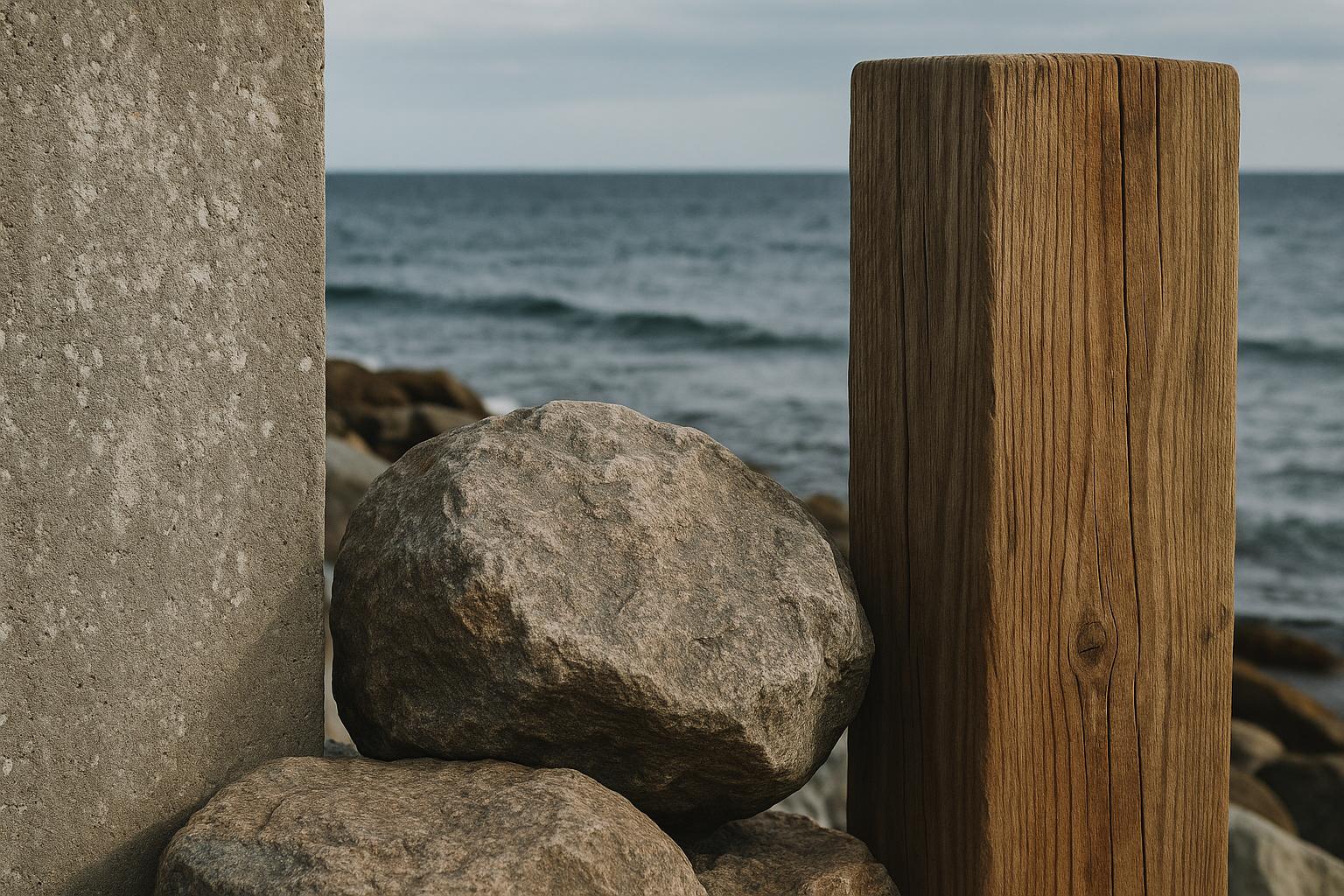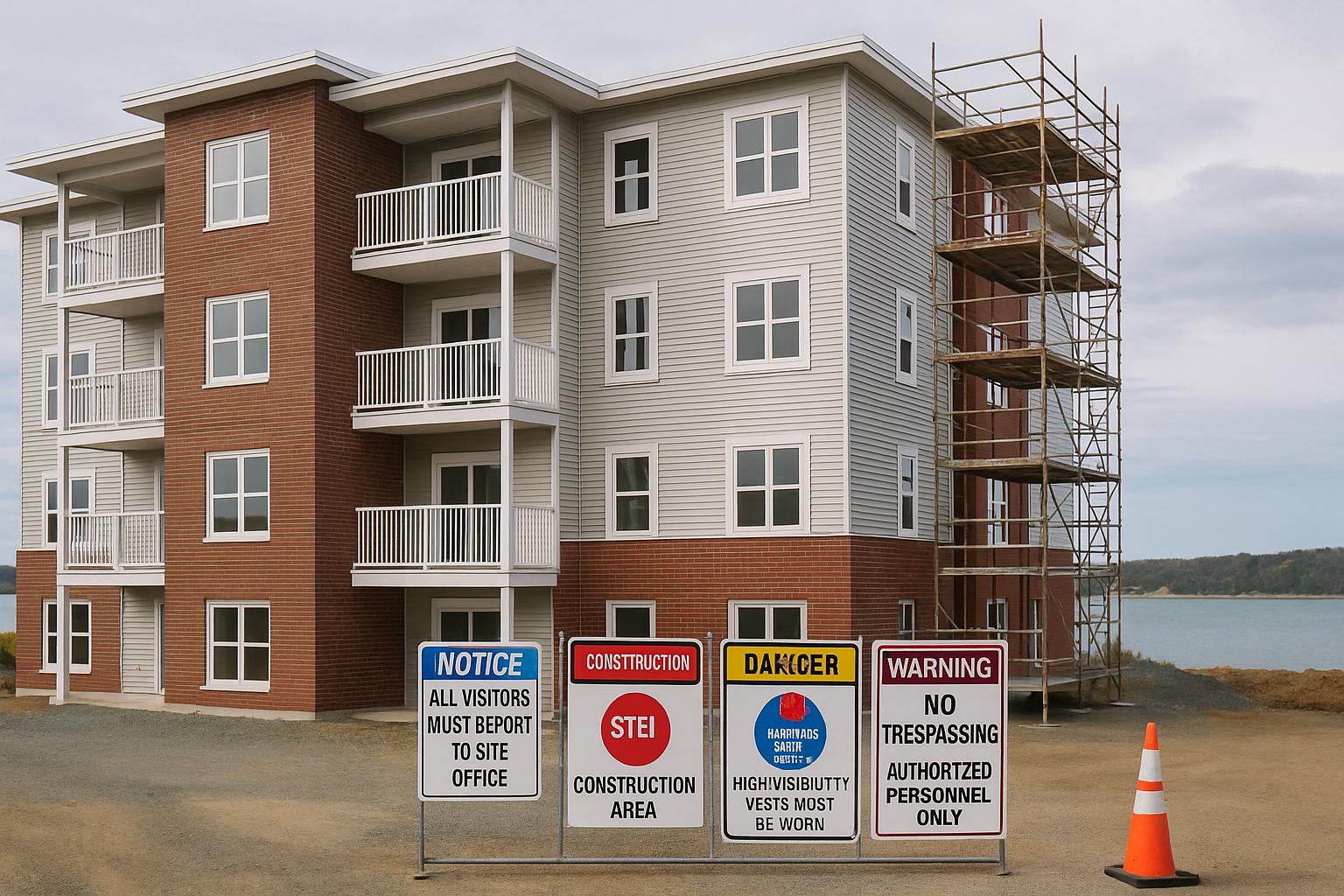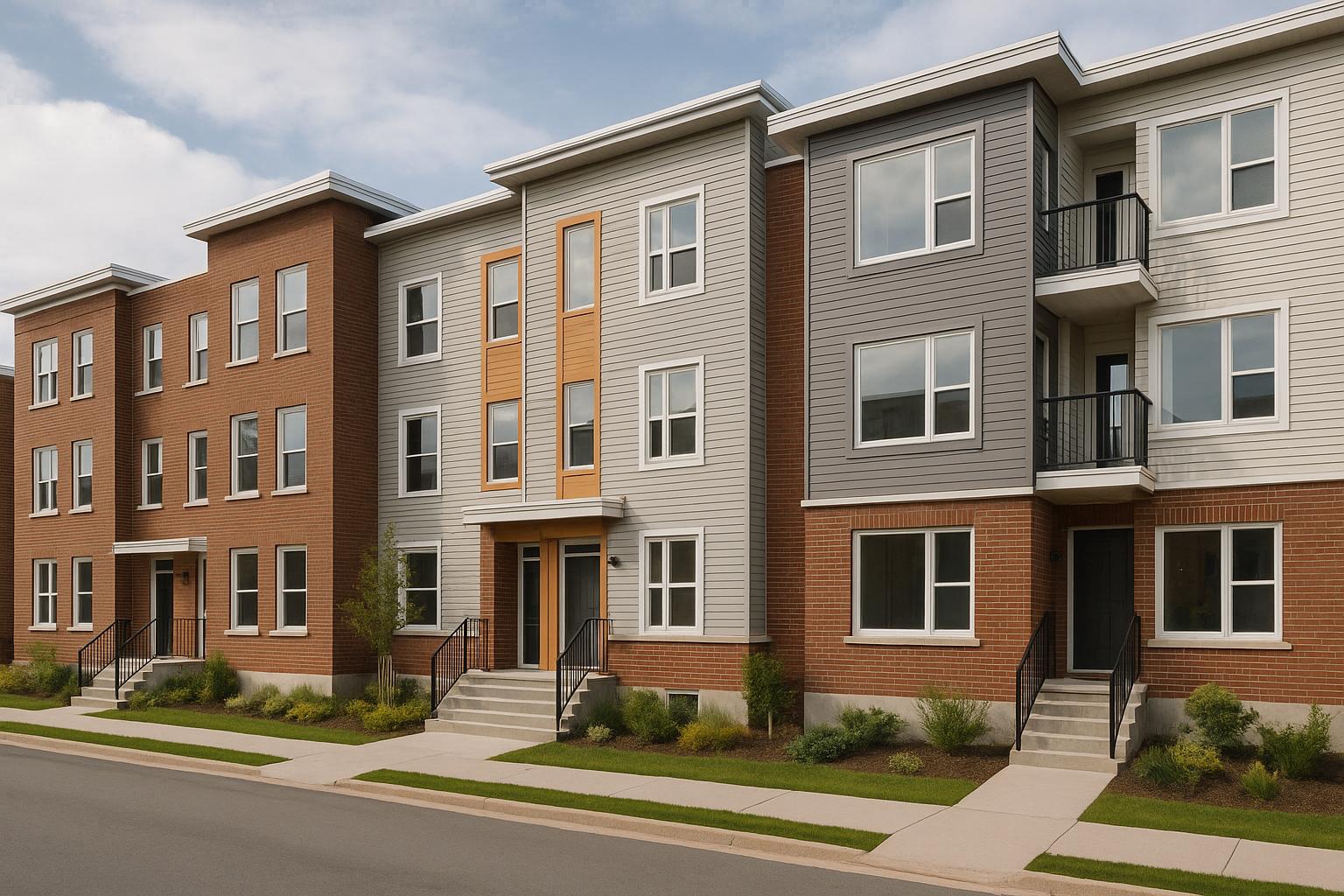When building rental properties in Nova Scotia, the choice between Insulated Concrete Forms (ICF) and wood frame construction depends on your priorities: upfront costs, long-term savings, and climate resilience. Here’s the quick takeaway:
- ICF offers better energy efficiency, durability, and weather resistance but comes with higher upfront costs and requires specialized labour.
- Wood frame construction is cheaper to build and faster to complete but may lead to higher maintenance and energy expenses over time.
Key Differences:
- Cost: ICF costs approx. $200,000+ per unit vs. $160,000 for wood frame.
- Energy Efficiency: ICF is about 40% more efficient, reducing heating costs in Nova Scotia’s cold winters.
- Durability: ICF handles moisture, pests, and freeze-thaw cycles better.
- Construction Speed: Wood frame is faster to build, ideal for short construction seasons.
- Flexibility: Wood frame allows easier design changes during construction.
Bottom Line:
- Choose ICF if you’re focused on long-term energy savings, lower maintenance, and durability.
- Opt for wood frame if upfront cost and faster returns are your top priorities.
Here’s how to decide based on your goals, budget, and Nova Scotia’s climate.
Efficiency Test & Results of ICF vs Conventional Framing.
Insulated Concrete Forms: Benefits and Drawbacks
Insulated Concrete Forms (ICF) construction provides some clear advantages for properties in Nova Scotia's demanding climate. However, it also comes with certain challenges that homeowners and developers should weigh carefully before committing to this approach.
ICF Benefits for Nova Scotia Properties
ICF construction is designed to handle the unique demands of Nova Scotia's weather. Its continuous insulation helps cut down on thermal bridging, which is a major factor in heat loss. This feature can lead to noticeable savings on heating bills - an important consideration in a province with cold winters and fluctuating temperatures.
The airtight design of ICF structures helps keep drafts at bay, creating a more stable indoor temperature even during Nova Scotia's notorious coastal winds. This not only improves comfort for occupants but also reduces complaints from tenants in rental properties.
ICF is also built to withstand Atlantic storms, freeze–thaw cycles, and high moisture levels, which helps protect buildings from mould, structural damage, and rot. Plus, its resistance to pests adds another layer of durability.
Another standout feature is its sound insulation. ICF construction significantly reduces noise transmission between units, making it an appealing choice in competitive rental markets where tenants value peace and quiet.
On top of that, ICF walls provide strong fire resistance, offering an added layer of safety compared to traditional wood frame construction. This could even lead to more favourable insurance rates, depending on the provider.
ICF Construction Challenges
While ICF has its strengths, it does come with some drawbacks. One of the most notable is its higher upfront cost. While the long-term energy savings and durability may balance this out over time, the initial investment can be a hurdle for some projects.
Another challenge is the need for specialized labour. Since ICF construction is less common in some areas, finding skilled workers with experience in this method can be tough. This lack of local expertise can extend construction timelines, especially when combined with weather-related delays or mistakes during assembly, which can lead to cost overruns.
Adding to the complexity, integrating electrical and plumbing systems into ICF walls requires meticulous planning. Once the concrete is poured, making adjustments becomes expensive and difficult.
Lastly, while ICF works well for many straightforward multi-unit designs, it can be less suited for complex architectural layouts, such as buildings with large openings or designs that require significant changes during construction. This can limit its flexibility for certain projects.
Wood Frame Construction: Advantages and Disadvantages
Wood frame construction is a popular choice for multi-unit residential projects in Nova Scotia. While this traditional method comes with several practical perks, it also poses challenges, particularly in the province's coastal climate. Let’s dive into both the benefits and the difficulties of this approach.
Benefits of Wood Frame Construction
One of the biggest advantages of wood frame construction in Nova Scotia is the availability of skilled labour. Many local contractors, carpenters, and tradespeople are well-versed in this method. This expertise often translates into competitive pricing, faster project timelines, and smoother overall execution.
When it comes to cost, wood frame construction is easier on the budget compared to alternatives like Insulated Concrete Form (ICF). The lower upfront material costs make it an attractive option for property owners looking to manage expenses without sacrificing quality.
Another plus is the flexibility it offers in design. During construction, adjustments like changing room layouts or re-routing plumbing and electrical systems can be done more easily and affordably. This adaptability is especially useful in projects where plans might evolve.
Speed is also a key factor. Skilled crews can frame wood structures quickly, which is critical given Nova Scotia’s short construction season. On top of that, the materials are readily available from local suppliers, reducing the risk of delivery delays and keeping cash flow steady. However, despite these advantages, wood frame construction isn’t without its challenges.
Challenges of Wood Frame Construction
Nova Scotia’s coastal climate brings specific challenges to wood frame construction. One major issue is thermal bridging. Wooden studs can create pathways for heat to escape, making it harder to achieve energy efficiency standards.
Moisture is another significant concern in the region’s humid environment. Without careful attention to vapour barriers, flashing, and ventilation, wood frame buildings can face problems like mould, rot, and even structural damage.
The freeze-thaw cycles common in Nova Scotia can also take a toll. Repeated expansion and contraction can cause settling, cracks, or gaps, which not only affect the building’s energy performance but may also lead to costly maintenance down the road.
Pest problems are another consideration. Wood frame construction can attract insects and rodents, creating potential headaches for property owners and tenants alike. Addressing these issues often requires additional pest control measures, which can add to operational costs.
Noise can also be a concern. Without proper acoustic design, sound transmission between units may lead to tenant dissatisfaction, impacting retention rates.
Finally, wood frame buildings tend to require more frequent maintenance. Exterior components like siding, trim, and roofing are particularly vulnerable to Nova Scotia’s unpredictable weather. Over time, these upkeep needs can increase the long-term costs of managing the property.
sbb-itb-16b8a48
ICF vs Wood Frame: Side-by-Side Comparison
Consider the trade-offs between upfront costs and long-term performance when choosing your construction method.
Construction Method Comparison Chart
| Factor | ICF Construction | Wood Frame Construction |
|---|---|---|
| Initial Cost | Approximately $200,000+ per unit | Around $160,000 per unit |
| Construction Speed | May require additional curing time and precise scheduling | Typically faster, with some projects finishing in six months using integrated techniques |
| Energy Efficiency | About 40% more energy efficient | Meets standard building code requirements |
| Climate Resistance | Provides better protection against moisture and freeze-thaw cycles | Needs careful moisture control to prevent issues |
| Design Flexibility | Harder to modify once concrete sets | Easier to adjust during the building process |
This chart highlights key differences in cost, speed, and performance. While ICF construction comes with a higher price tag, it offers energy savings and durability over time. On the other hand, wood frame construction is quicker and more affordable upfront.
For property owners planning to hold onto their investment for 20 years or more, ICF offers advantages that go beyond energy efficiency. Its durability, lower maintenance needs, and eligibility for programs like CMHC MLI Select financing can provide added value over the long haul.
Nova Scotia's coastal climate, with its freeze-thaw cycles, high humidity, and unpredictable weather, can take a toll on traditional wood frame structures. In such conditions, ICF's resilience makes it a strong contender, potentially reducing long-term maintenance costs.
Choosing the right construction method depends largely on your financial goals and how they align with the challenges of Nova Scotia's climate. If immediate cash flow is your priority, wood frame construction could be the better choice. However, for those with a long-term perspective, ICF's performance and durability might justify the investment. Up next, discover how integrated design–build approaches can simplify these decisions.
Design-Build Construction: Better Results for Property Owners
Traditional construction projects often leave property owners juggling multiple contracts, dealing with communication breakdowns, and facing rising costs. This fragmented approach can stretch timelines, inflate budgets, and create unnecessary stress.
Design-build construction takes a different path. Instead of managing separate entities, property owners work with one company responsible for everything - from the initial design phase to the final stages of construction. This streamlined process eliminates the common pitfalls of miscommunication and accountability gaps that plague traditional methods.
Why Integrated Construction Delivers Better Outcomes
The design-build model solves many of the challenges associated with traditional construction. By offering single-point responsibility, it ensures one entity is accountable for the entire project. This approach prevents the blame-shifting that often leads to delays and cost overruns. According to the Design-Build Institute of America, 76% of design-build projects stay on or under budget, compared to just 61% for traditional design-bid-build projects [1].
Fixed-price contracts provide property owners with cost certainty upfront, quoted in Canadian dollars. This eliminates surprise expenses that can disrupt financing or derail a project.
Guaranteed timelines are another key advantage. By overlapping the design and construction phases, projects move faster. A 2021 study by the Construction Industry Institute found that design-build projects are completed 33% faster and cost 6% less on average compared to traditional approaches [2]. For Nova Scotia property owners, this speed means rental income can start flowing sooner.
The structured delivery process of design-build replaces the chaos of traditional methods with detailed project management. Continuous schedule monitoring allows potential problems to be identified and resolved early. Change orders - a common budget killer - are reduced by up to 5.2% compared to traditional methods [2], providing further financial stability.
Another major benefit is risk transfer. Design-build contracts often include penalties for missed deadlines or cost overruns, holding the contractor accountable and protecting the property owner.
Example: Helio Urban Development's Streamlined Approach
Helio Urban Development is a prime example of how the design-build model works in practice. As the only integrated design-build company in Nova Scotia focused on 4+ unit rental properties, Helio eliminates the coordination headaches that typically fall on property owners.
Helio addresses the three most common failures in traditional construction: poor coordination among professionals, budget overruns of 30–60%, and extended timelines that stretch projects from 8 months to over 18 months. By combining planners, architects, engineers, and construction teams under one roof, Helio guarantees fixed-price construction at $160,000 per unit within 6 months.
Their commitment to accountability goes beyond promises. Helio backs its timeline guarantees with penalties of up to $1,000 per day for delays. For property owners expecting monthly rents between $1,950 and $2,100, this level of certainty protects revenue streams.
Currently, Helio has 31 units under construction and 131 more in the planning stages, serving property owners across Nova Scotia. This consistent performance demonstrates how systematic project delivery can succeed across various sites and project types.
Co-founder Lloyd Liu, who holds an MBA from Yale and previously worked as an investment banker at Merrill Lynch, emphasizes the importance of accountability:
I personally guarantee every timeline because I've felt the pain of construction delays.
Helio also prioritizes quality control. Their projects include a triple quality verification process and a 2-year warranty, ensuring high standards are met throughout construction. This level of oversight is difficult to achieve when managing separate contractors.
For property owners deciding between ICF (insulated concrete forms) and wood frame construction, working with an integrated design-build firm simplifies the process. These firms evaluate material options based on project goals, local climate, and long-term durability, ensuring the choice aligns with financial objectives and Nova Scotia's challenging weather conditions.
[1] Design-Build Institute of America
[2] Construction Industry Institute
Choosing the Right Construction Method for Nova Scotia
Deciding between ICF (Insulated Concrete Forms) and wood frame construction comes down to your project's goals, budget, and timeline. Both methods can handle Nova Scotia's climate well, but they cater to different priorities, especially for property owners building rental units. Here's how they compare in terms of financial returns and operational demands.
Wood frame construction is often the more budget-friendly option. It comes with lower upfront costs and quicker build times, allowing you to start collecting rental income sooner. For example, units built for approximately $160,000 each can generate monthly rents in the range of $1,950 to $2,100. This approach is ideal if your focus is on achieving faster returns on investment.
On the other hand, ICF construction is better suited for projects where long-term durability and energy efficiency are top priorities. While the initial costs are higher, ICF buildings require less ongoing maintenance and can attract tenants willing to pay higher rents. However, this approach demands careful financial planning to manage the upfront investment.
Both methods are effective in Nova Scotia's coastal winters when executed properly. Wood frame construction, combined with triple-pane windows and high-quality insulation, offers solid thermal performance. ICF, meanwhile, provides additional benefits like enhanced thermal mass and greater resistance to harsh weather, though at a higher cost.
Interestingly, tenants in Nova Scotia tend to care more about affordability and high-quality finishes than the construction method itself. Features like ductless heat pumps, engineered hardwood flooring, and quartz countertops are what truly capture their attention - not whether the building is made of wood or concrete.
Another critical factor is how the construction process is managed. Complex, fragmented construction often leads to delays and coordination issues, regardless of the materials used. An integrated design-build approach can solve these problems by offering single-point accountability for material selection, construction quality, and meeting timelines.
As highlighted in the design-build section, a systematic approach to project delivery - using fixed-price contracts, guaranteed timelines, and professional coordination - often has a greater impact on success than the choice of building materials. Property owners who prioritize reliable processes over material debates tend to see better financial results and fewer headaches.
For most rental projects in Nova Scotia, wood frame construction provides the best mix of affordability, performance, and market appeal. ICF is worth considering only if your project has specific needs that justify its higher costs.
FAQs
What are the financial advantages of using Insulated Concrete Forms instead of wood framing for rental properties in Nova Scotia?
Choosing Insulated Concrete Forms (ICF) instead of traditional wood framing for rental properties in Nova Scotia offers notable long-term financial benefits. ICF buildings excel in energy efficiency, often cutting heating and cooling expenses by up to 50%. In a province like Nova Scotia, where the climate can be unpredictable, these savings can make a big difference in reducing utility bills over time.
Beyond energy savings, ICF structures are built to last, often surpassing a lifespan of 100 years. This durability translates to lower repair and maintenance costs throughout the building’s life. While construction with ICF typically costs 3–5% more upfront compared to wood framing, the reduced energy costs, minimal upkeep, and ability to withstand harsh weather make it a smart, long-term investment for property owners.
What are the advantages of the design-build approach for construction projects in Nova Scotia?
The design-build method provides a practical solution for construction projects in Nova Scotia by merging the design and construction phases into one cohesive process. This streamlined approach helps cut down on delays, improves teamwork, and delivers more consistent outcomes.
With design and construction happening simultaneously, projects can wrap up 40–50% faster than with traditional methods. This overlap reduces the chances of miscommunication between teams, resulting in fewer mistakes and a smoother workflow. For property owners, this translates to less hassle, improved efficiency, and a dependable way to see their projects through to completion.
Which is better for energy efficiency and climate resilience in Nova Scotia: ICF or wood frame construction?
When comparing Insulated Concrete Forms (ICF) to wood frame construction in Nova Scotia, two critical considerations stand out: energy efficiency and climate resilience. ICF structures are known to consume up to 41% less electricity and at least 5% less natural gas, providing superior energy performance and consistent indoor temperatures. This translates into noticeable savings on utility bills while keeping your home comfortable throughout the year.
ICF also offers exceptional resistance to moisture, mould, pests, and fire, making it a strong contender for Nova Scotia's humid and unpredictable weather conditions. While wood frame construction may have a lower initial cost, the durability and insulation benefits of ICF often lead to reduced long-term maintenance and energy expenses. For a region with such distinct weather challenges, ICF stands out as a practical and resilient option.



